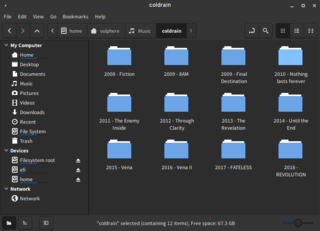A file manager or file browser is a computer program that provides a user interface to manage files and folders. The most common operations performed on files or groups of files include creating, opening, renaming, moving or copying, deleting and searching for files, as well as modifying file attributes, properties and file permissions. Folders and files may be displayed in a hierarchical tree based on their directory structure. Some file managers contain features inspired by web browsers, including forward and back navigational buttons.

The graphical user interface is a form of user interface that allows users to interact with electronic devices through graphical icons and visual indicators such as secondary notation, instead of text-based user interfaces, typed command labels or text navigation. GUIs were introduced in reaction to the perceived steep learning curve of command-line interfaces (CLIs), which require commands to be typed on a computer keyboard.

Konqueror, a free and open-source web browser and file manager, provides web access and file-viewer functionality for file systems. It forms a core part of the KDE Software Compilation. Developed by volunteers, Konqueror can run on most Unix-like operating systems. The KDE community licenses and distributes Konqueror under the GNU General Public License version 2.

The World Wide Web (WWW), commonly known as the Web, is an information system where documents and other web resources are identified by Uniform Resource Locators, which may be interlinked by hypertext, and are accessible over the Internet. The resources of the WWW may be accessed by users by a software application called a web browser.

A web browser is a software application for accessing information on the World Wide Web. When a user opens a particular website, the web browser retrieves the necessary content from a web server then displays the resulting web page on the user's device.

Drupal is a free and open-source content management framework written in PHP and distributed under the GNU General Public License. Drupal provides a back-end framework for at least 2.3% of all websites worldwide – ranging from personal blogs to corporate, political, and government sites. Systems also use Drupal for knowledge management and for business collaboration.

In computer interface design, a toolbar is a graphical control element on which on-screen buttons, icons, menus, or other input or output elements are placed. Toolbars are seen in many types of software such as office suites, graphics editors and web browsers. Toolbars are usually distinguished from palettes by their integration into the edges of the screen or larger windows, which results in wasted space if too many underpopulated bars are stacked atop each other or interface inefficiency if overloaded bars are placed on small windows.
A navigation bar is a section of a graphical user interface intended to aid visitors in accessing information. Navigation bars are implemented in file browsers, web browsers and as a design element of some web sites.
Web analytics is the measurement, collection, analysis and reporting of web data for purposes of understanding and optimizing web usage. However, Web analytics is not just a process for measuring web traffic but can be used as a tool for business and market research, and to assess and improve the effectiveness of a website. Web analytics applications can also help companies measure the results of traditional print or broadcast advertising campaigns. It helps one to estimate how traffic to a website changes after the launch of a new advertising campaign. Web analytics provides information about the number of visitors to a website and the number of page views. It helps gauge traffic and popularity trends which is useful for market research.
Google Analytics is a tool which shows real time traffic of your website.
According to IFABC Global Web Standards, a unique user (UU) is "An IP address plus a further identifier. The term "unique visitor" may be used instead of "unique user" but both terms have essentially the same meaning. Sites may use User Agent, Cookie and/or Registration ID." Note that where users are allocated IP addresses dynamically, this definition may overstate or understate the real number of individual users concerned.
An HTTP cookie is a small piece of data sent from a website and stored on the user's computer by the user's web browser while the user is browsing. Cookies were designed to be a reliable mechanism for websites to remember stateful information or to record the user's browsing activity. They can also be used to remember arbitrary pieces of information that the user previously entered into form fields such as names, addresses, passwords, and credit card numbers.
Path analysis, is the analysis of a path, which is a portrayal of a chain of consecutive events that a given user or cohort performs during a set period of time while using a website, online game, or eCommerce platform. As a subset of behavioral analytics, path analysis is a way to understand user behavior in order to gain actionable insights into the data. Path analysis provides a visual portrayal of every event a user or cohort performs as part of a path during a set period of time.
The front controller software design pattern is listed in several pattern catalogs and related to the design of web applications. It is "a controller that handles all requests for a website", which is a useful structure for web application developers to achieve the flexibility and reuse without code redundancy.
Mobile web analytics studies the behavior of mobile website visitors in a similar way to traditional web analytics. In a commercial context, mobile web analytics refers to the use of data collected as visitors access a website from a mobile phone. It helps to determine which aspects of the website work best for mobile traffic and which mobile marketing campaigns work best for the business, including mobile advertising, mobile search marketing, text campaigns, and desktop promotion of mobile sites and services.
Web navigation refers to the process of navigating a network of information resources in the World Wide Web, which is organized as hypertext or hypermedia. The user interface that is used to do so is called a web browser.
A web beacon is one of various techniques used on web pages and email, to unobtrusively allow checking that a user has accessed some content. Web beacons are typically used by third parties to monitor the activity of users at a website for the purpose of web analytics or page tagging. They can also be used for email tracking. When implemented using JavaScript, they may be called JavaScript tags.


















